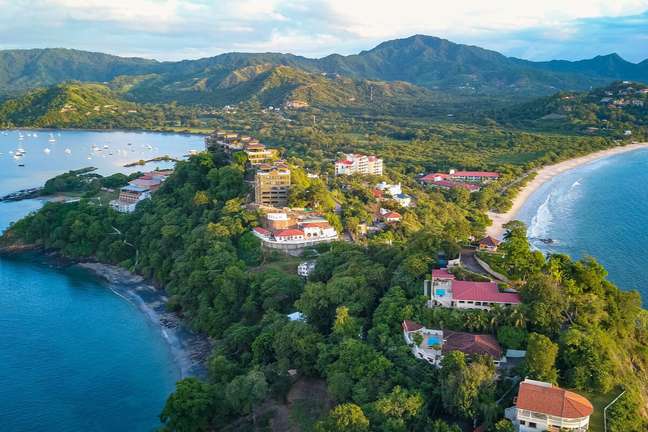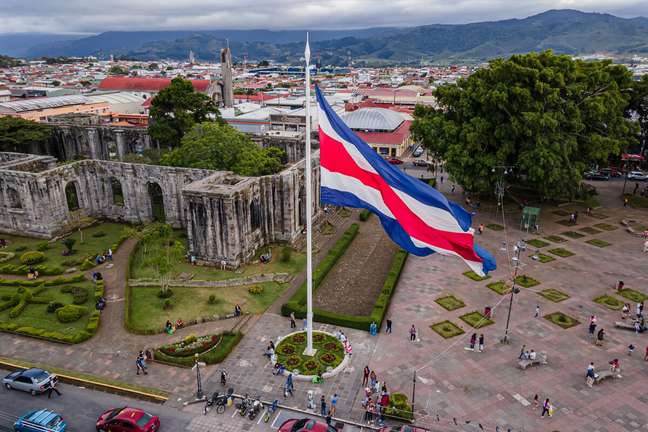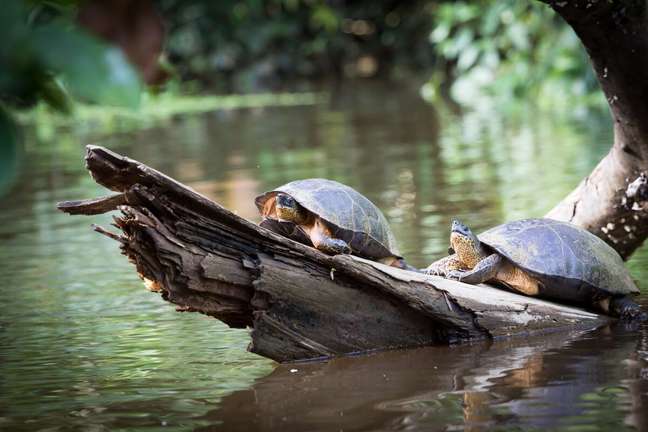The countryside presents itself to the world as one of the best itineraries to escape the urban chaos
Costa Rica presents the world with huge parks, lagoons and paradisiacal beaches, as well as cities full of history, tradition and music. Hiking and exploring volcanoes, ziplining, swimming with whales and dolphins, or simply practicing yoga and enjoying the fantastic hot springs are some of the sightseeing options in this diverse Central American country.

The opportunities for total immersion in nature are endless: just choose between forest, beach or mountain, and you will be rewarded with wildlife, exotic and endemic plants and spectacular views. Learn more about the place!
Best time to visit
The climate in Costa Rica is hot almost every month of the year. On the Pacific coast, there is a well-defined dry season (December to March) and a rainy season (May to October). In the Caribbean region there are two relatively dry periods, between February and March and between September and October.
How to get
The gateway to the country is its capital, San José, an agricultural center that became prosperous in the mid-1950s. Situated on the fertile plateau of the Central Valley, approximately 1,100 meters above sea level. Flights between Brazil and San José are operated by Copa Airlines via Panama City and American Airlines via Miami.
city of san jose
San José is located in the geographical center of the country and plays the role of political and commercial heart of Costa Rica, after a long past which has kept it in the background compared to the coastal cities🇧🇷 One way to understand the city is to visit local markets and museums such as:
Central Market and Craft Market
At the Mercado Central and Mercado Artesanal, you can get in touch with the most authentic side of the city and its inhabitants. In them it will be possible to come into contact with an explosion of colors and scents, as well as taste the delicious fried bananas, a typical dish of the local cuisine.
Pre-Columbian Gold Museum and National History Museum
The city of San José offers tours of some interesting museums. One of them is the Pre-Columbian Gold Museum, which brings together an immense amount of gold artifacts made by pre-Columbian civilizations and a rich collection of coins recovered from Spanish galleons sunk along the coast. Another interesting trip is to the National Museum of History, located in the former Spanish Fortress Bellavista.

Old metropolis Carthage
Cartago was the capital of Costa Rica until 1823, when they decided to move the capital to San José. This is the most important region of the country in terms of colonial art: perhaps the best example is the Templo de Orosí (1743), a historical jewel that bears witness to the birth of a nation.
Cartago has a humid tropical climate, and its mountain system includes two chains: the central one, where the Irazù and Turrialba volcanoes are located, and the Talamanca, the other major mountain formation in the province. On it stands the impressive Cerro Chirripó mountain, the highest point in Costa Rica, reaching 3,600 meters above sea level.
Cartago is a land of tradition and religiosity. The pilgrimage to the Basilica of Nossa Senhora dos Anjos, in the city center, is the most important religious activity. It is celebrated on August 2 and brings together millions of people from all over the country. They pay their respectful homage and place their requests upon a three-inch black stone statuette of the Virgin, affectionately nicknamed “La Negrita.”
tourism in Costa Rica
Irazú Volcano National Park
Another must-see attraction is the Irazú Volcano National Park, in the canton of Oreamuno, 32 km away. North East from the city of Carthage. It is the highest active volcano in the country, with its 3,432 meters of height. The name derives from an Indian village built in 1569 on its slopes, whose name means “the peak of thunder and earthquake”.
The volcano covers a territory of more than 500 square kilometers and has at least 10 volcanic cones on the south side. However, the main attraction of the park is the climb to the Deigo Haya crater, which has turned into a green lake over the years. On clear days it is possible to see both the Atlantic and Pacific Oceans from its summit.
Turrialba
On the slopes of the volcano of the same name, Turrialba is home to two universities. It is especially famous among fans of the raftingwho appreciate canyons and waterfalls by Pacuare. The river has been ranked by experts as one of the top 10 rafting of the world. On the way down numerous birds and monkeys can be seen along the way.
For more than 100 years, a cream-colored soft cheese has been produced in the area, obtained from raw milk using artisanal methods. The Turrialba volcano, the second highest in the country at 3,340 meters, erupted again in 2016 after a century of inactivity.
Guayabo National Monument
Also worth a quick visit is the Guayabo National Monument, with an area of 218 hectares and located 84 km from San José. It is the largest and most interesting archaeological area in Costa Rica. It was partially discovered (only 10%) in the 60s by the explorer Anastasio Alfaro. In 1973 it was declared a national monument.
Ideal location to enjoy nature
Manuel Antonio National Park
The beauties of the country are not limited to the capital and its environs. In Quepos, province of Puntarenas, the Manuel Antonio National Park is home to more than 350 species of birds, 109 mammals and 346 plants. Its paths are a hymn to fauna and flora and lead to magnificent accessible beaches located within the park.
The park, located 130 km from the capital, has white beaches and lush forest, where you can admire pools and waterfalls, jungle and paths immersed in tropical vegetation, rich in many native animals that populate it.
Look up to see the beautiful sloths clinging to the branches of the tall trees. In invigorating walks you can photograph toucans, chameleons, frogs, toads and the famous red-eyed terns. The park also includes 12 islets and often, swimming in the waters, it is possible to pet dolphins or admire whales from afar.

Tortuguero National Park
In Tortuguero National Park, located to the northeast, thousands of sea turtles build nests and lay their eggs on black sand beaches. More than 400 bird species, 60 frog species, 40 fish and 3 monkey species live in the park itself. A “little Amazon” to visit along the rivers that cross it. The shores gradually narrow and the boat is enveloped in thicker vegetation. A natural cathedral where the visitor remains silent and fascinated.
Ballena Marine National Park
This marine park was created to conserve the corals and reefs that surround several islands along the coast. Its name is due, in addition to the humpback whales that come here to reproduce, also to the “Whale tail” of Punta Uvita, a characteristic strip of sand that extends inside a rocky barrier and which, at low tide, comes with the whale tail.
Marino Ballena National Park, located just 16 km south of Dominical and 180 km southwest of San José, protects more than 13,000 hectares of sea and nine miles of It costs🇧🇷 Despite its limited size, the reserve is of great importance, especially for the colonies of dolphins and sea turtles that come there to nest, as well as for the colony of seabirds and different species of reptiles. There are four beaches in the park.
Province of Lemon
In the province of Limón, right to left, this area is a natural paradise, formed by a combination of dense jungles, imposing mountains and paradisiacal beaches. Limón has the highest percentage of protected land in Costa Rica and has a wide variety of flora and fauna. The vegetation is exuberant, as are the cultures that converge throughout the province.
Arenal Volcano
Nature lovers, you’ve come to the right place: the Arenal Volcano, 120 km northwest of San José, in the Tilaran mountain range, is one of the main attractions of the country and of the park of the same name. Be careful, though, that no one can wander along the slopes of the volcano: it is extremely dangerous. It is possible to witness the descent of incandescent lava, but also simple explosions of gas and ash. A place of extraordinary biodiversity, it is home to half of the country’s known species of birds, mammals and reptiles.
Text originally published in the journal Qual Viagem (Edition 87).
By Claudio Lacerda Oliva
🇧🇷The best content in your email for free. Choose your favorite Terra newsletter. Click here!
Source: Terra
Camila Luna is a writer at Gossipify, where she covers the latest movies and television series. With a passion for all things entertainment, Camila brings her unique perspective to her writing and offers readers an inside look at the industry. Camila is a graduate from the University of California, Los Angeles (UCLA) with a degree in English and is also a avid movie watcher.

![It All Begins Here: What’s in store for Monday 27th October 2025 Episode 1293 [SPOILERS] It All Begins Here: What’s in store for Monday 27th October 2025 Episode 1293 [SPOILERS]](https://fr.web.img6.acsta.net/img/41/39/413989e0bd493a6d9c6b47c276d6bcf1.jpg)


